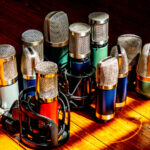Surf Era Guitar Paint has become a sought-after aesthetic for guitars, evoking a vintage vibe and a cool, retro feel. However, just like camera megapixels don’t guarantee great photos, simply slapping on “surf era guitar paint” doesn’t automatically result in a stunning guitar finish. Many factors contribute to a truly exceptional paint job, and focusing solely on the color name is missing the bigger picture.
The Guitar Body: The Foundation Matters
Think of the guitar body as the lens of a camera. Even the most vibrant “surf era” hue will look lackluster if applied to a poorly prepared surface. If the wood isn’t properly sanded and primed, imperfections will show through, and the paint won’t adhere correctly. A cheap, uneven body is like a crappy single-element lens – it will undermine the potential of even the most meticulously chosen paint. Just as a photographer invests in quality lenses, guitar enthusiasts should appreciate the importance of a well-prepared guitar body as the foundation for any “surf era guitar paint” finish.
Paint Material: The True Sensor of Color and Quality
The paint itself acts as the sensor in our guitar paint analogy. Just as a camera sensor captures light and translates it into an image, the paint material holds the pigment and determines the color’s depth and richness. Using cheap, low-quality paint, even in the perfect “surf era” shade, is akin to a camera sensor struggling with noise and interpolation. You might get the right color in theory, but the finish will lack vibrancy, depth, and durability. Pigment quality, the type of paint (nitrocellulose, polyurethane, etc.), and the primer used all play crucial roles in the final look and longevity of your “surf era guitar paint”. Don’t be fooled by just the color – the material itself is paramount.
Painting Technique: Processing the Perfect Finish
The application process is like the image processor of our guitar paint scenario. A camera’s image processor converts raw sensor data into a viewable JPEG. Similarly, the painting technique transforms the paint material into a finished guitar body. Just as poor image processing can ruin a photo through excessive compression or artifacts, improper painting techniques can devastate a “surf era guitar paint” job. Thick, uneven coats, drips, and lack of proper clear coating can obscure the beauty of the color and result in a finish that’s far from professional. Skilled application, involving thin, even coats, proper sanding between layers, and a high-quality clear coat, is essential to “process” the paint into a flawless, eye-catching “surf era guitar paint” finish.
Paint Detail: Beyond Just Color Pixels
Finally, consider the details in the paint finish as the “pixels” of our guitar. While a high pixel count in a camera allows for greater enlargement and detail, in guitar paint, details like metallic flakes, pearlescent sheens, or subtle color shifts add depth and visual interest to “surf era guitar paint”. However, just as digital zoom is a poor substitute for optical zoom and true image detail, simply adding glitter to paint doesn’t guarantee a sophisticated or appealing finish. The quality and execution of these details are crucial. A well-applied metallic flake in “surf era guitar paint” can create a stunning, dynamic effect, while poorly executed details can look cheap and detract from the overall aesthetic.
Ultimately, achieving a truly exceptional “surf era guitar paint” finish is about more than just choosing the right color from the past. It demands attention to detail in every aspect, from body preparation and paint material selection to skillful application and thoughtful incorporation of details. Focusing on these elements, rather than solely on the “surf era” label, will result in a guitar finish that truly stands out and captures the essence of that vintage vibe.


